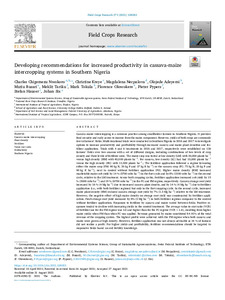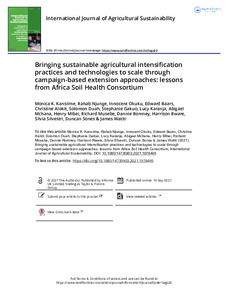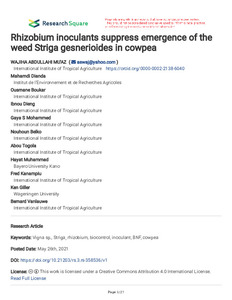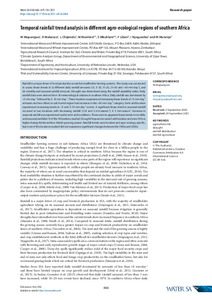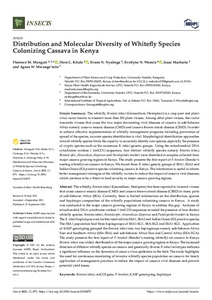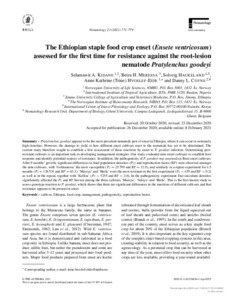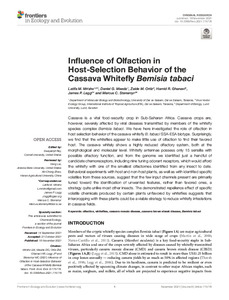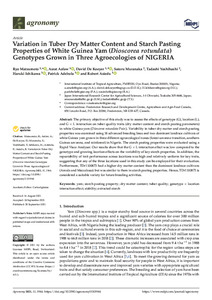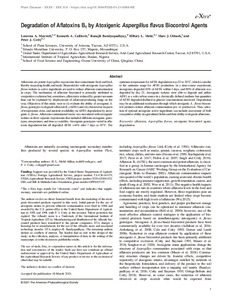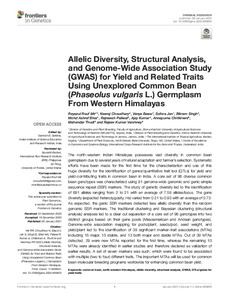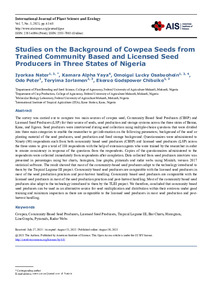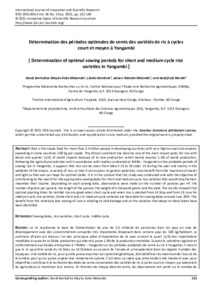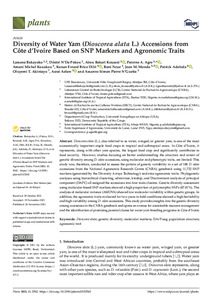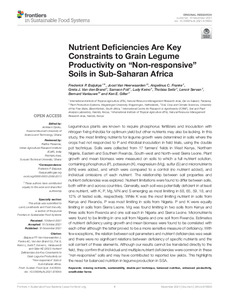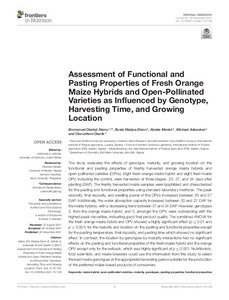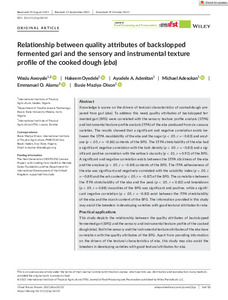Welcome to the International Institute of Tropical Agriculture Research Repository
Journal and Journal Articles: Recent submissions
Now showing items 921-940 of 5271
-
Developing recommendations for increased productivity in cassava-maize intercropping systems in southern Nigeria
(2021)Cassava-maize intercropping is a common practice among smallholder farmers in Southern Nigeria. It provides food security and early access to income from the maize component. However, yields of both crops are commonly low in farmers’ fields. Multi-locational trials were conducted in Southern Nigeria in 2016 and 2017 to investigate options to increase productivity and profitability through increased cassava and maize plant densities and fertilizer application. Trials with 4 and 6 treatments in 2016 ... -
Bringing sustainable agricultural intensification practices and technologies to scale through campaign-based extension approaches: lessons from Africa Soil Health Consortium
(2021)Sustainable agricultural intensification (SAI) practices have been developed with the aim of increasing agricultural productivity. However, most of them are not achieving their potential because of low adoption, linked to limited extension support to make them known and accessible by end-users. This paper reviews the effectiveness of the Africa Soil Health Consortium (ASHC) extension-based campaigns, contributing knowledge for formulating novel and cost-effective extension approaches. Results show ... -
Rhizobium inoculants suppress emergence of the weed Striga gesnerioides in cowpea
(2021)Cowpea is a grain legume of major importance in sub-Saharan Africa where it is cultivated by smallholder farmers on poor soils and production is often constrained by the parasitic weed Striga gesnerioides. Experiments were conducted to assess the potential of rhizobium inoculation in mitigating Striga infestation and increasing cowpea productivity. We tested under basal P application and artificial S. gesnerioides inoculation the impact of cowpea genotypes (G) (nine Striga-resistant and 11 Striga– ... -
Temporal rainfall trend analysis in different agro-ecological regions of southern Africa
(2021-10)Rainfall is a major driver of food production in rainfed smallholder farming systems. This study was conducted to assess linear trends in (i) different daily rainfall amounts (<5, 5–10, 11–20, 21–40 and >40 mm∙day-1), and (ii) monthly and seasonal rainfall amounts. Drought was determined using the rainfall variability index. Daily rainfall data were derived from 18 meteorological stations in southern Africa. Daily rainfall was dominated by <5 mm∙day-1 followed by 5–10 mm∙day -1. Three locations ... -
Mechanisms and approaches towards enhanced drought tolerance in cassava (Manihot esculenta)
(2021)Cassava (Manihot esculenta Crantz) is cultivated in tropical and subtropical regions for its edible tuberous roots and minimally for its leaves. It provides food and revenue to over eight hundred million people particularly in Africa. Generally, cassava is drought-tolerant, and sheds leaves in drought conditions resulting in significantly lower yields. Cassava drought management strategies need to focus on maximizing the utilization of molecular tools for crop establishment and yield. Developing ... -
Distribution and molecular diversity of whitefly species colonizing cassava in Kenya
(2021)The whitefly, Bemisia tabaci (Gennadium, Hemiptera) has been reported to transmit viruses that cause cassava mosaic disease (CMD) and cassava brown streak disease (CBSD) in many parts of sub-Saharan Africa (SSA). Currently, there is limited information on the distribution, species and haplotype composition of the whitefly populations colonizing cassava in Kenya. A study was conducted in the major cassava growing regions of Kenya to address this gap. Analyses of mitochondrial DNA cytochrome oxidase ... -
The Ethiopian staple food crop enset (Ensete ventricosum) assessed for the first time for resistance against the root-lesion nematode Pratylenchus goodeyi
(2021)Pratylenchus goodeyi appears to be the most prevalent nematode pest of enset in Ethiopia, where it can occur in extremely high densities. However, the damage to yield or how different enset cultivars react to the nematode has yet to be determined. The current study therefore sought to establish a first assessment of these reactions by enset to P. goodeyi infection. Determining pest-resistant cultivars is an important task in developing management strategies. Our study evaluated nine enset cultivars ... -
Influence of olfaction in host-selection behavior of the cassava whitefly Bemisia tabaci
(2021-11)Cassava is a vital food-security crop in Sub-Saharan Africa. Cassava crops are, however, severely affected by viral diseases transmitted by members of the whitefly species complex Bemisia tabaci. We have here investigated the role of olfaction in host selection behavior of the cassava whitefly B. tabaci SSA-ESA biotype. Surprisingly, we find that the whiteflies appear to make little use of olfaction to find their favored host. The cassava whitely shows a highly reduced olfactory system, both at ... -
Variation in tuber dry matter content and starch pasting properties of white Guinea yam (Dioscorea rotundata) genotypes grown in three groecologies of Nigeria
(2021)The primary objective of this study was to assess the effects of genotype (G), location (L), and G × L interaction on tuber quality traits (dry matter content and starch pasting parameters) in white Guinea yam (Dioscorea rotundata Poir.). Variability in tuber dry matter and starch pasting properties was examined using 18 advanced breeding lines and two dominant landrace cultivars of white Guinea yam grown in three different agroecological zones (forest‒savanna transition, southern Guinea savanna, ... -
Degradation of aflatoxins B1 by atoxigenic Aspergillus flavus biocontrol agents
(2021-09)Aflatoxins are potent Aspergillus mycotoxins that contaminate food and feed, thereby impacting health and trade. Biopesticides with atoxigenic Aspergillus flavus isolates as active ingredients are used to reduce aflatoxin contamination in crops. The mechanism of aflatoxin biocontrol is primarily attributed to competitive exclusion but, sometimes, aflatoxin is reduced by greater amounts than can be explained by displacement of aflatoxin-producing fungi on the crop. Objectives of this study were to ... -
Allelic diversity, structural analysis, and genome-wide association study (GWAS) for yield and related traits using unexplored common bean (Phaseolus vulgaris L.) Germplasm from Western Himalayas
(2021-01)The north-western Indian Himalayas possesses vast diversity in common bean germplasm due to several years of natural adaptation and farmer’s selection. Systematic efforts have been made for the first time for the characterization and use of this huge diversity for the identification of genes/quantitative trait loci (QTLs) for yield and yield-contributing traits in common bean in India. A core set of 96 diverse common bean genotypes was characterized using 91 genome-wide genomic and genic simple ... -
Studies on the background of cowpea seeds from trained community based and licensed seed producers in three states of Nigeria
(2021)The survey was carried out to compare two main sources of cowpea seed, Community Based Seed Producers (CBSP) and Licensed Seed Producers (LSP) for their source of seeds, seed production and storage systems across the three states of Benue, Kano, and Jigawa. Seed producers were interviewed during seed collection using multiple-choice questions that were divided into three main categories to enable the researcher to get information on the following parameters; background of the seed or planting ... -
Characterizing cassava farmer typologies and their seed sourcing practices to explore opportunities for economically sustainable seed business models in Rwanda
(2021)The overdependency on local cassava varieties and informal seed sources by farmers in Rwanda has contributed to the spread of cassava viral diseases. The use of improved planting materials made available through formal seed sources, that assure seed quality, is one way to prevent future disease outbreaks. In order to increase the availability of, and farmers access to, such materials there is increasing interest to develop seed business models. This study aims to understand seed sourcing practices ... -
Determination des periodes optimales de semis des varietes de riz a cycles court et moyen a Yangambi
(2021-09)Rice is the staple food for more than 2.5 billion people in developing countries with very high annual consumption exceeding in some countries 100 kg per capita. The African continent has become one of the main import poles for rice with about one quarter (1/4) of world imports because of its low production, which barely reaches 1.5% of world production. Following the agricultural calendar and in accordance with studies conducted at INERA - Yangambi on the probable periods of sowing rice in Yangambi, ... -
Diversity of water yam (Dioscorea alata L.) accessions from Cote d'Ivoire based on SNP markers and agronomic traits
(2021)Dioscorea alata (L.), also referred to as water, winged, or greater yam, is one of the most economically important staple food crops in tropical and subtropical areas. In Côte d’Ivoire, it represents, along with other yam species, the largest food crop and significantly contributes to food security. However, studies focusing on better understanding the structure and extent of genetic diversity among D. alata accessions, using molecular and phenotypic traits, are limited. This study was, therefore, ... -
Nutrient deficiencies are key constraints to grain legume productivity on "non-responsive" soils in sub-Saharan Africa
(2021)Leguminous plants are known to require phosphorus fertilizers and inoculation with nitrogen fixing rhizobia for optimum yield but other nutrients may also be lacking. In this study, the most limiting nutrients for legume growth were determined in soils where the crops had not responded to P and rhizobial inoculation in field trials, using the double pot technique. Soils were collected from 17 farmers' fields in West Kenya, Northern Nigeria, Eastern and Southern Rwanda, South-west and North-west ... -
Identification of quantitative trait nucleotides and candidate genes for tuber yield and mosaic virus tolerance in an elite population of white guinea yam (Dioscorea rotundata) using genome-wide association scan
(2021)Background Improvement of tuber yield and tolerance to viruses are priority objectives in white Guinea yam breeding programs. However, phenotypic selection for these traits is quite challenging due to phenotypic plasticity and cumbersome screening of phenotypic-induced variations. This study assessed quantitative trait nucleotides (QTNs) and the underlying candidate genes related to tuber yield per plant (TYP) and yam mosaic virus (YMV) tolerance in a panel of 406 white Guinea yam (Dioscorea ... -
Assessment of functional and pasting properties of fresh orange maize hybrids and open-pollinated varieties as influenced by genotype, harvesting time, and growing location
(2021)The study evaluates the effects of genotype, maturity, and growing location on the functional and pasting properties of freshly harvested orange maize hybrids and open-pollinated varieties (OPVs). Eight fresh orange maize hybrid and eight fresh maize OPV, including the control, were harvested at three stages: 20, 27, and 34 days after planting (DAP). The freshly harvested maize samples were lyophilized and characterized for the pasting and functional properties using standard laboratory methods. ... -
Cassava Brown Streak Disease response and association with agronomic traits in elite Nigerian cassava cultivars
(2021)Cassava mosaic geminiviruses (CMGs) and cassava brown streak viruses (CBSVs) cause the highest yield losses in cassava production in Africa. In particular, cassava brown streak disease (CBSD) is and continues to be a significant constraint to optimal cassava production in Eastern and Southern Africa. While CBSD has not been reported in West Africa, its recent rapid spread and damage to cassava productivity in Eastern, and Southern Africa is alarming. The aim of this study was to evaluate Nigerian ... -
Relationship between quality attributes of backslopped fermented gari and the sensory and instrumental texture profile of the cooked dough (eba)
(2022-01)Knowledge is scarce on the drivers of textural characteristics of cooked dough prepared from gari (eba). To address this need, quality attributes of backslopped fermented gari (BFG) were correlated with the sensory texture profile analysis (STPA) and instrumental texture profile analysis (ITPA) of the eba produced from six cassava varieties. The results showed that a significant and negative correlation exists between the STPA mouldability of the eba and the sugar (p < .05, r = −0.83) and amylose ...

